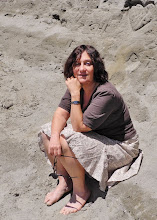 |
| Violinist Sharan Leventhal |
I still consider Sharan Leventhal's room at Meadowmount to have been the gravitational center of the Main House activities. I'll never forget when I entered one day during off-limit practice hours, and found her engrossed in painting the white blank walls with a fantastic array of blues and greens for an ocean scene, complete with a marvelously voluptuous orange and yellow mermaid. "Sharan, won't you get in trouble for this? I mean, it's against the rules to paint the walls, and you're supposed to be practicing!" But she shrugged and proceeded to pencil sketch a giant starfish with surrounding exotic sea-life, and then resumed painting. Before long, the room was awash in color, like her imaginative violin playing.
Then, of course, there were the nightly seances, after curfew, that Sharan hosted in her room in secrecy. We must have spent countless hours trying to contact the spirit of actress Sharan Tate, murdered by the Charles Manson gang, and other dead souls. I tried to channel my grandmother that summer but to no avail. Sharan had a penchant for delving into other-worldly spheres, perhaps an early indicator of her keen interest and dedication to unconventional and non-traditional music, as well as the talent she has for breathing life into standard repertoire.
In a recent telephone call to her home outside of Boston, where she teaches at Boston Conservatory and Brandeis, I inquired about her latest musical endeavors. I heard the enthusiasm in her voice as she described her commitment to performing the works of living, breathing, vital composers. She has premiered the violin concertos of Bob Aldridge and Scott Wheeler, to name a few.
With her colleagues from the Boston Conservatory, second violinist Eric Segnetz, violist Brek Renzelman, and cellist Karl Lavine of the Kepler String Quartet, they have just released the second of a series of American composer Ben Johnston's quartets for New World Records. The Kepler Quartet was formed specifically for the preservation and presentation of this large body of work. "Making these recordings was an exploration along the lines of discovering the North Pole or being the first to climb Mt. Everest," she said.
The first composition presented on this new release is Quartet No. 5, based on an Appalachian gospel tune, "The Lonesome Valley". The extended just intonation in this work offered composer Ben Johnston an opportunity to present harmonic, melodic, and contrapuntal textures using a mutable tuning system. This type of tuning lends the music a strange quality, meant to evoke Psalm 23 in the Old Testament: the valley refers to the valley of the shadow of death. So haunting are the actual sounds, that I feel as if I'm experiencing my own dissolution and death.
In the tenth Quartet, the work opens with a jazzy polyrhythmic style (the first violin and cello are out of synch with each other) while displaying a harmony that is tonal but extended in a playful way. In one dazzling passage, the first violin launches into a riff that recalls the naturalness and ease of my favorite Jazz violinist, Stephane Grappeli. The shimmer vibrato and lush tone that Sharan infuses in her solo line emphasizes the characteristic bold colors of her playing.
The final quartet featured on this disc, "Nine Variations" is avant-grade, as Johnston composed the work in his early thirties and used the technique of serialism. There is no theme in this work. The nine movements alternate between slow and fast, calm and energetic. Although I'm not enamored of these variations...yet...they do encourage the listener to hear music in a different way through silences, shrieks, and utterances.
I found my husband Ilkka's reaction to the disc most interesting. Blessed with perfect pitch and synesthesia (the mixing up of senses) he hears pitches accompanied with visions of colors. I begged him to come down to the studio and listen to a few movements with me to find out which hues flashed through his mind. As he listened to the assortment of these non-traditional tones with the expanded pitch vocabulary encompassing 150 steps into an octave rather than 12, he suffered a bout of sensory overload and panic attack (similar to what he experiences in shopping malls), and, before I knew it, fled the studio!



